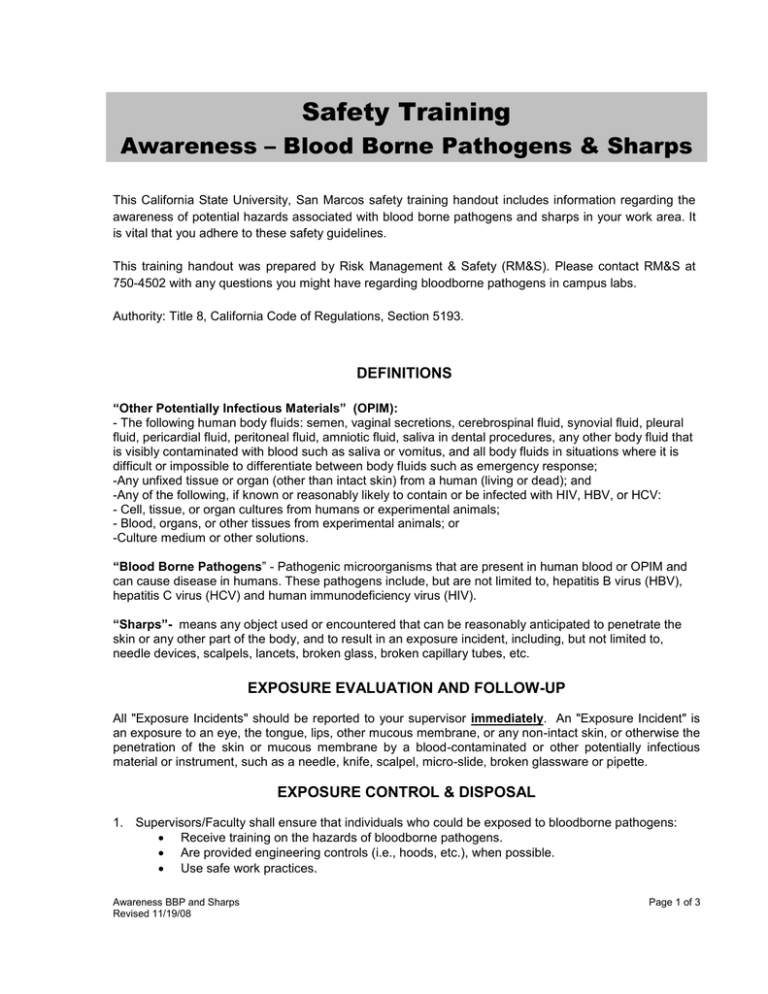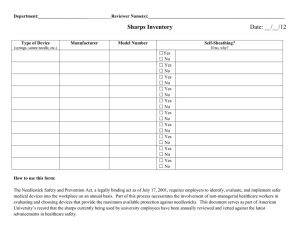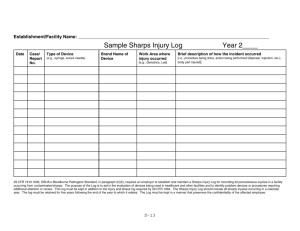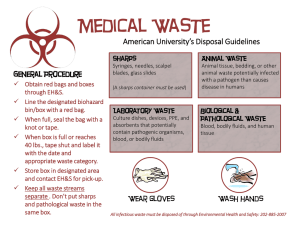Bloodborne Pathogen Awareness and Sharps Disposal Management - ALL USERS
advertisement

Safety Training Awareness – Blood Borne Pathogens & Sharps This California State University, San Marcos safety training handout includes information regarding the awareness of potential hazards associated with blood borne pathogens and sharps in your work area. It is vital that you adhere to these safety guidelines. This training handout was prepared by Risk Management & Safety (RM&S). Please contact RM&S at 750-4502 with any questions you might have regarding bloodborne pathogens in campus labs. Authority: Title 8, California Code of Regulations, Section 5193. DEFINITIONS “Other Potentially Infectious Materials” (OPIM): - The following human body fluids: semen, vaginal secretions, cerebrospinal fluid, synovial fluid, pleural fluid, pericardial fluid, peritoneal fluid, amniotic fluid, saliva in dental procedures, any other body fluid that is visibly contaminated with blood such as saliva or vomitus, and all body fluids in situations where it is difficult or impossible to differentiate between body fluids such as emergency response; -Any unfixed tissue or organ (other than intact skin) from a human (living or dead); and -Any of the following, if known or reasonably likely to contain or be infected with HIV, HBV, or HCV: - Cell, tissue, or organ cultures from humans or experimental animals; - Blood, organs, or other tissues from experimental animals; or -Culture medium or other solutions. “Blood Borne Pathogens” - Pathogenic microorganisms that are present in human blood or OPIM and can cause disease in humans. These pathogens include, but are not limited to, hepatitis B virus (HBV), hepatitis C virus (HCV) and human immunodeficiency virus (HIV). “Sharps”- means any object used or encountered that can be reasonably anticipated to penetrate the skin or any other part of the body, and to result in an exposure incident, including, but not limited to, needle devices, scalpels, lancets, broken glass, broken capillary tubes, etc. EXPOSURE EVALUATION AND FOLLOW-UP All "Exposure Incidents" should be reported to your supervisor immediately. An "Exposure Incident" is an exposure to an eye, the tongue, lips, other mucous membrane, or any non-intact skin, or otherwise the penetration of the skin or mucous membrane by a blood-contaminated or other potentially infectious material or instrument, such as a needle, knife, scalpel, micro-slide, broken glassware or pipette. EXPOSURE CONTROL & DISPOSAL 1. Supervisors/Faculty shall ensure that individuals who could be exposed to bloodborne pathogens: Receive training on the hazards of bloodborne pathogens. Are provided engineering controls (i.e., hoods, etc.), when possible. Use safe work practices. Awareness BBP and Sharps Revised 11/19/08 Page 1 of 3 Use indicated Personal Protective Equipment (PPE) such as gloves, particle face mask, lab coat and safety glasses. 2. If the nature of the task, activity or job requires direct contact with human blood or other potentially infectious materials, PPE shall be available and worn. Use of PPE will not be used in the exposure determination process. If a procedure is performed without blood exposure, but exposure could occur in an accident or emergency, the PPE shall be available. 3. Universal Precautions are intended to supplement rather than replace routine infection control recommendations, such as hand washing and use of gloves to prevent contamination of hands. Universal Precautions, in part, assume that all human blood, blood products and other potentially infectious materials are infected and present a hazard to anyone being exposed to the agents. Consequently, if contact with infectious agents is possible, the necessary PPE must either be worn or be immediately available. 4. To prevent injuries caused by needles, scalpels, and other sharps; workers should not recap, bend or attempt to cut needles from disposable syringes. They shall be placed directly into the sharps container. Rigid sharps containers shall be colored red and labeled with the word "BIOHAZARD", or will have a biohazard label * (refer to example below). The container will also have a generator label that contains the university name, address and phone number. 5. Sharps containers are to be properly marked with the international biohazard symbol. Sharps, even after sterilization, are considered to be a biomedical waste. Sharps will always be disposed of properly in the designated sharps container. Individuals should cease using a sharps container when the sharps container is “¾” full. Sharps should never be forced into a container. Individuals should never attempt to recap needles. Sharps containers must be sealed prior to disposal. SPECIAL PRACTICES & AUTHORITY 1. Laboratory doors shall be kept closed when work is performed on bloodborne pathogens. The area is to be posted with the biohazard sign. Access to the work area shall be limited to authorized persons. Only persons trained in biohazards may be authorized to enter work areas and animal rooms. 2. Laboratory areas shall remain secured and locked when not in use. 3. The California Department of Public Health (CDPH) Environmental Management Branch regulates the collection, storage, transportation and disposal of sharps and medical wastes. Sharps are regulated by the Medical Waste Management Act (Section 117705 of the California Health and Safety Code). It is “ILLEGAL” to improperly dispose of Hazardous Waste, which includes “SHARPS”, in the state of California and on our University Campus. 4. Enforcement of the Blood Borne Pathogen Standard is the responsibility of the California Department of Industrial Relations (Cal/OSHA). It is found in CCR Title 8, Chapter 4 (Division of Industrial Safety), Sub-Chapter 7 (General Industry Safety Orders), Group 16 (Control of Hazardous Substances), Article 109 (Hazardous Substances and Processes). Awareness BBP and Sharps Revised 11/19/08 Page 2 of 3 ACKNOWLEDGEMENT You will not be permitted to handle blood borne pathogens until you: Have completed this training Have had your questions answered Have been trained by your respective supervisor to recognize hazards and protect yourself from potential exposure to them Have signed your training acknowledgement I affirm that I have been trained in the awareness of blood borne pathogens and the proper disposal of sharps. Name (Print): ________________________________ Date: ___________________ Signature: _________________________________________________________ Email:________________________________________ Status (Circle One) : Student Staff Faculty Department: _______________________________ Supervisor/Instructor Signature:___________________________________________ ** Please maintain the training handout for your reference and return the signed acknowledgement page to Risk Management & Safety. Awareness BBP and Sharps Revised 11/19/08 Page 3 of 3



